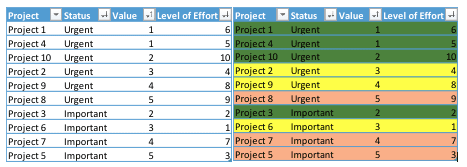If you are old enough to remember the 1992 elections, you most likely remember Ross Perot, the billionaire candidate for the independent party. One of the things he frequently did when speaking was use the phrase, “That’s my top priority.” Soon, the press noticed it and it became somewhat of a running joke.
As project managers, we realize that if everything is a top priority, nothing is. As a survival guide, I have a few tips to help you manage different items and organize your plan.
-
Make a list (and check it twice)
First, make a list and check it twice (or even three times). Knowing what you have to do is just as important as a priority. This list can be your starting point for the schedule. I usually start with a simple spreadsheet. Documenting these gives you the big picture of what is needed to complete the task or project.
-
Know the difference between urgent and important
Determine the difference between urgent and important. Important items can occur throughout the project, but urgent ones typically take place early on or scheduled at definitive times. This is another column that should be added to your spreadsheet. It is also good to recognize if any of the urgent items have deadlines. This will become important when sequencing them.
-
Determine the value of the task
Who wants the task? If it is a major stakeholder such as the CEO or project sponsor, promote the task higher in your list. Client projects tend to be higher than internal projects for me. Payroll issues come before writing training manuals. I typically rate these on a scale of 1-5 with 1 being a higher value. Again, use an appropriate scale for you, but as you begin identifying your priorities, keep in mind those items that are value added, revenue generating, or important to the stakeholders within your organization.
-
Categorize by effort
Look at the level of effort for the project or task. You can use the unit of measure (hours, weeks, etc.) to grade this. When choosing to tackle these, many productivity experts recommend choosing the lengthier tasks first. Don’t use high, medium, low for a list of 100 items. You’ll be left with too large of a group to sort in the end.
-
Let the sorting begin
Sorting on the first column gives you all the urgent tasks for instance. If you do a secondary sort on the value column, you can determine urgent, high-value tasks. Then finally, you have the level of effort. By now, a clear pattern of priority should start to appear. If not, expand your criteria for sorting. Maybe you need a scale of 1-10 instead of high, medium, low. Adding shading or colors to certain tasks might help visualize the pattern.

Conclusion
In the table on the left above, I have a pretty straightforward sort. My top four projects based on the first sort are 1, 4, 10, and 2. After looking a bit deeper, I can see that project three has a higher value than Project 2. After adding some basic colors, I can easily highlight my priorities.
Another thing to note is that there are also times to just table projects or items that don’t rate high enough, are not urgent enough, and their level of effort is just too high. This type analysis can be brought to the appropriate stakeholders to help in this type of decision-making.
JEFF L. CHAMBERLAIN, PMP | Project Manager
Jeff comes to KTL Solutions with an extensive background in healthcare IT, technical consulting, and telecommunications. He has been a project manager for almost 20 years, holding certifications from the Project Management Institute as a Project Management Professional, from the Management and Strategy Institute as a Six Sigma Lean Professional, and he holds a Scrum Master Certification from the Scrum Alliance. He has managed both hardware and software implementations for both the government and private sectors, in industries such as healthcare, insurance, telecommunications, staff augmentation, supply chain and shipping.
Jeff has provided training for clients globally, working in Europe, Russia, North and South America on various topics from system optimization to wireless theory and design. He possesses a Bachelor’s Degree in Technical Writing from the University of Baltimore.




































